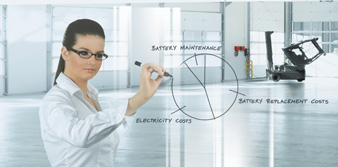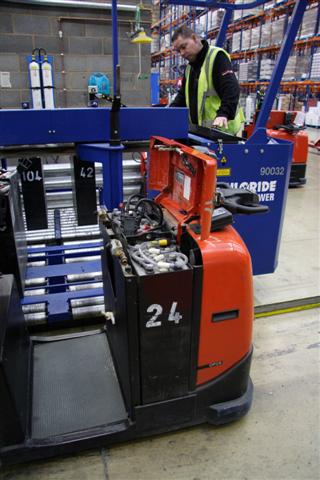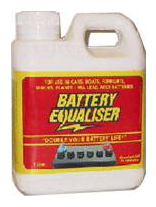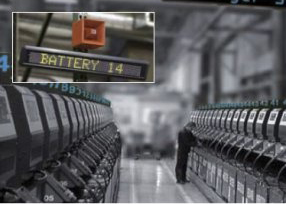 Calculating the benefits of battery power.
PHOTO: FRONIUS |
Battery-powered forklifts make up about half of the total global fleet and continue to compete with internal combustion (IC) versions. Latest figures from the US Industrial Trucks Association, the body representing the major manufacturers and importers, show 45,361 electric forklifts shipped in 2008 - compared to 62,104 IC models.
According to a Mitsubishi Forklift Trucks datasheet, electric forklift trucks are ideal for working indoors while IC forklifts are ideal for outdoor use. However, advances in technology mean that battery equipment can be operated outdoors, "but only on dry, well paved surfaces", while propane forklifts are taking some marketshare for indoor use.
Dealers point out that electric forklifts are powered by large, heavy lead-acid batteries - bigger, more powerful versions of the batteries used in passenger vehicles. The batteries typically provide enough power for one standard eight-hour shift, although capacity is continually being improved. However, long charging cycles are a major disadvantage - but one which also is being addressed.
Batteries at workBritish retailer Sainsburys is not a typical materials handling organisation; its distribution centre at Swan Valley, Northampton is touted as Europe's greenest distribution centre.
With more than 160 electric vehicles, Sainsburys is a significant battery user, and materials handling manager Derek Boghurst has been instrumental in encouraging three of the leading truck manufacturers to develop trucks that can take a standard battery case with higher capacities.
 Exide batteries is use at Sainsburys |
His motivation has been to try and reduce the number of batteries required for the fleet, and with co-operation from suppliers, he has managed to get this down to 269.
Sainsburys has been working with leading manufacturer Exide, and its power array includes 105 high-frequency chargers, Exide filling systems and a 2100.Net Battery Management System.
"Poor rotation of batteries is problematical for a number of reasons. Lead-acid batteries, if left too long, will self-discharge and crystallisation (known as sulphation) takes place on the battery's plates. "Sulphation affects the reaction between the negative and positive plates, which in turn impedes the generation of the electrical current," says Vic Sayer, the Exide senior key account manager for Sainsburys .
On the other hand, batteries that get used extensively will reach the end of their service life more quickly because batteries have a finite number of cycles.
Exide's 2100.Net system monitors the charging profile of each battery and instructs the operator which battery to take next. If a battery is taken that has not been fully charged, an audible warning system is activated.
Improved technologyBattery manufacturers continue to work with forklift OEMs to ensure there are specially designed batteries to custom fit each of their battery electric models, says Fiona Berry, Australian marketing manager (motive power) with Century Yuasa Batteries. "We then tailor fit the chargers and accessories to the customers' power requirements."
But producers are also working to improve their core technology and CenturyYuasa is planning to shortly unveil unique glass tube technology in its cells. Glass tube technology offers superior reliability and increased service life in high heat conditions, Berry explains. "It also significantly reduces the rate of shedding from the positive plate due to the tighter weave in the material used."
The sulphation issue identified by Exide's Sayer can be avoided, according to Paul Davy, managing director of Australian-based battery technology company, Energytech.
"When a battery is recharged, most of the sulphate crystals dissolve," he explains. "However, not all the crystals dissolve so, over time, there is a gradual accumulation of these crystals on the battery plates. As this accumulation progresses, active material is drawn from the battery electrolyte (dilute sulphuric acid), weakening the acid and inhibiting the electrochemical process the battery uses to function," he says, adding that this causes a gradual decline in the battery's ability to store energy, with a consequent effect on productivity.
Davy says battery health is often ignored and by the time operators notice the impact, it's often too late. To address this, his company supplies a range of products and services to diagnose a battery's state of health and dissolve accumulated sulphates.
 Battery Equaliser |
In similar vein, Grahame Graf of Battery Equaliser Australia Pty Ltd says his product improves battery chemistry to prevent sulfation in new batteries and break up existing sulfation in older batteries.
"Tests have shown that because the product reduces the internal resistance within the battery, the battery takes the charge on more easily and holds the charge for longer," he says.
He adds that although the product was first developed for use in new batteries, it also revitalises sulphated deadened batteries with controlled use. This has led to the development of a new battery reconditioning business activity that has successfully collected, re-energised and returned to service tens of tons of batteries. These would otherwise have ended up scrapped and returned to the highly polluting lead smelting and alloy separation and refinement process, he adds.
MaintenanceRefilling is an essential part of battery maintenance, according to Brad Trask, a director of another Australian battery technology company, Blink International, who says topping up of forklift batteries is critical in terms of life expectancy and productive performance.
"The key requirement is maintaining the correct water-to-electrolyte balance to enable the battery to deliver it power capabilities consistently. A poorly maintained battery will have a significantly reduced performance life," he says, explaining that a battery that is topped up at the wrong time will overfill and leak onto the warehouse floor when it is recharged as the charger readjusts the water levels during the charge process.
"The battery must only be topped up when it is fully charged as this is when the water levels are at their highest," he adds.
Blink International supplies a battery filling system that enables the operator to assess whether or not the battery requires topping up at a glance. His system, he says, is "a proven performer in a harsh environment". It does not rely on a specific water pressure to perform. Another unique feature is the manner in which the water movements and the extraction of dangerous hydrogen gases during charging are separated - something that has profound safety significance.
 Philadelphia Scientific's battery maintenance system |
Chris Parkinson, Philadelphia Scientific's Asia Pacific region director, laments the lack of comprehensive battery management. "Unbelievably, there are still large battery sites that have no management systems or use a basic 'first-in, first-out' queuing system," he notes. His company's advanced iBOS system can be used for remote reporting and support for battery chargers, including detailed reporting of the present condition and operation history of specific batteries. A thorough management system should record battery assets and their maintenance history, he advises. Such an approach allows end-users to "fully utilise their assets and will commonly pay for itself within the first year of operation", he adds. These savings are particularly relevant in the current tough economic climate. When businesses look at how often they replace their batteries, how many batteries they need and how much it costs to maintain those batteries, they can save much more if they are prepared to invest a small amount in appropriate systems and technology, he says.
RechargingUnlike IC forklifts which are simply refilled when they run out of fuel, forklift batteries need to be recharged frequently, thoroughly and using specialised equipment.
One provider, Fronius, claims its Active Inverter Technology can increase the service life of the battery by around 25% and improve battery efficiency, thereby cutting costs.
The company claims its new technology is a significant improvement. Fronius says active inverter technology is energy efficient, delivers a constant level of power throughout the entire charging process, is compact in design and has high safety standards. The technology can help reduce ongoing operating costs and protect the environment.
Chargers based on inverter technology are slightly more expensive than conventional chargers that use 50 Hz transformer technology, but offer a number of advantages.
Also gaining market traction is eTEC's Minit-Charger FC. As reported recently, Minit-Charger products enable fast charging of forklift trucks using proprietary technologies (Forkliftaction.com News #410).The eTec equipment evaluates four battery factors-temperature, voltage, data state of charge and internal resistance-every 1.5 seconds and determines what energy to put back into the battery.
Besides a range of battery chargers, US-based Jamco offers a BDX portable battery discharger/load test unit which is unique. It is designed to discharge batteries from 12 to 96 volts with a current discharge of 200 amps.
A green futureLike all aspects of transport and logistics, environmental considerations continue to influence battery development.
CenturyYuasa has introduced a battery recycling program, encouraging customers to be environmentally aware and recycle their used lead acid batteries. Marketing manager Berry boasts that Century recycles 96% of a forklift battery cell. "The acid is turned into fertilizers, the poly-propylene into other plastic products and the lead is put back into new batteries. Century offers a collection service for forklift batteries and peace of mind that they will be recycled responsibly."
Disposal of dead batteries is only part of the issue, and enlightened suppliers insist the focus should instead be on extending the working life of batteries and on reducing the amount of electricity required to recharge them.
At the same time, equipment manufacturers are engineering improvements into their forklifts to reduce their energy needs.
Innovations such as regenerative braking which converts kinetic energy when the forklift slows into a storeable form of energy instead of dissipating it as heat are now commonplace among leading brands.
This system has been deployed in Still's RX70 hybrid forklift which was awarded the UK Fork Lift Truck Association's environmental award for 2008. The RX70 series goes a step further, combining electrics with diesel power in its hybrid design.
Visionaries dismiss hybrid solutions as dated, pushing instead for the "next big thing" in vehicle power, fuel cell technology.
Battery maker Fronius is among those which have developed a fuel cell. Its HYLOG (Hydrogen powered Logistic System) last year won the World Energy Globe award.
The technology replaces the current lead-acid batteries with a low-temperature fuel cell, fuelled by a hydrogen cartridge. This system eliminates time-intensive battery charging and is also completely emissions-free.
A number of major players are competing to develop commercially viable fuel cell-powered forklifts, the latest development coming earlier this month when Forklift manufacturer DanTruck A/S and H2 Logic A/S announced their collaboration (Forkliftaction.com News # 428).
The forklift market may be a niche market compared to cars, but DanTruck marketing chief Frank Rasmussen estimates that the global forklift market is worth over USD29.6 billion each year. DanTruck and H2 Logic are currently developing a second-generation hydrogen forklift that will be introduced to the market in the first quarter of 2010.
The next challenge, of course, will be the roll-out of hydrogen refueling stations and infrastructure, but already there are plans to develop this infrastructure in Europe and US.
And while this technology may still be a way off, batteries remain a key power source for forklifts. The significant size of the global fleet means that batteries will be around for a while to come, and suppliers will continue to innovate to improve performance, cost-efficiency, safety and environmental friendliness.